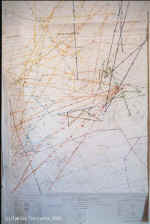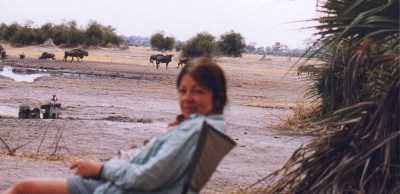I had no idea how much fun it is to set a
cheetah trap in Africa. Since we had to block the road to force that
cheetah to go through the trap, we placed branches all around it, and
branches in Africa are usually very thorny! And so, on a Saturday evening
(almost dark of course) and with minimal bleeding, we accomplished our goal. Our trap was
set, but the perpetrator never fell for it. Even female cheetah scat
used as bait was useless. The only glimpse we got of our visitor was his
silhouette, on the top of a road, right before sunset, showing off his beautiful
profile.
 He
was around alright. We could tell by the nightly commotion created by
captive cheetahs, dogs, jackals and every other living thing in the perimeter. In
fact, every time we went to check the trap, we found fresh prints all over, even
inside the trap! ...but no cheetah. I am sure he was watching us when our truck got stuck
in mud while checking the trap!
He
was around alright. We could tell by the nightly commotion created by
captive cheetahs, dogs, jackals and every other living thing in the perimeter. In
fact, every time we went to check the trap, we found fresh prints all over, even
inside the trap! ...but no cheetah. I am sure he was watching us when our truck got stuck
in mud while checking the trap!
We were luckier at tracking wild cheetahs
from the air.

Thanks to Jacques, a French pilot who owns a
four-seat airplane, the CCF is able to radio-track collared cheetahs every two
weeks.


Two at a time, EarthWatch volunteers got to
go on the plane with Bonnie and Jacques. Candice and I got the first
flight just after sunrise. The views were magnificent, and we got to see a
wild female with her cubs, just sitting pretty, making the landscape even more
beautiful with their presence.
The radio-tracking data has to be mapped in
order to follow the migratory and territorial patterns of wild cheetahs.
We got to do that for about twelve cheetahs currently collared, and it was
fascinating.
 Each
contact with a radio-collared cheetah is registered on a form, with the GPS
position, date, tag number, and any visual characteristics of the terrain, or of
the cheetah if seen at all. The information is transferred on to maps,
with each cheetah having a designated color. The results are about 16 maps
of the area with
lines that seem to travel forever --usually males, lines that look like small
clusters --usually females with cubs, and lines in between (single girls maybe?).
Each
contact with a radio-collared cheetah is registered on a form, with the GPS
position, date, tag number, and any visual characteristics of the terrain, or of
the cheetah if seen at all. The information is transferred on to maps,
with each cheetah having a designated color. The results are about 16 maps
of the area with
lines that seem to travel forever --usually males, lines that look like small
clusters --usually females with cubs, and lines in between (single girls maybe?).
Other things we got to help with were
organizing cheetah blood samples which, like the feces, had to be labeled, catalogued
and prepared for storage or shipment.
We also got to do some office work, like
entering lab samples data in the computer, or typing up the CCF library
catalog. I even got to see how the International Cheetah Studbook
works. This is where records are kept of every captive cheetah in the
world, and Laurie Marker is its keeper. Whether a cheetah is born,
transferred, or dies, information such as this is carefully tracked at the CCF.
While office work did not involve direct
contact with animals, keeping in mind that I was working for them helped me
enjoy it and feel proud of it. Besides, the office was next to the cubs'
pen so I could get a glimpse of them from time to time.
